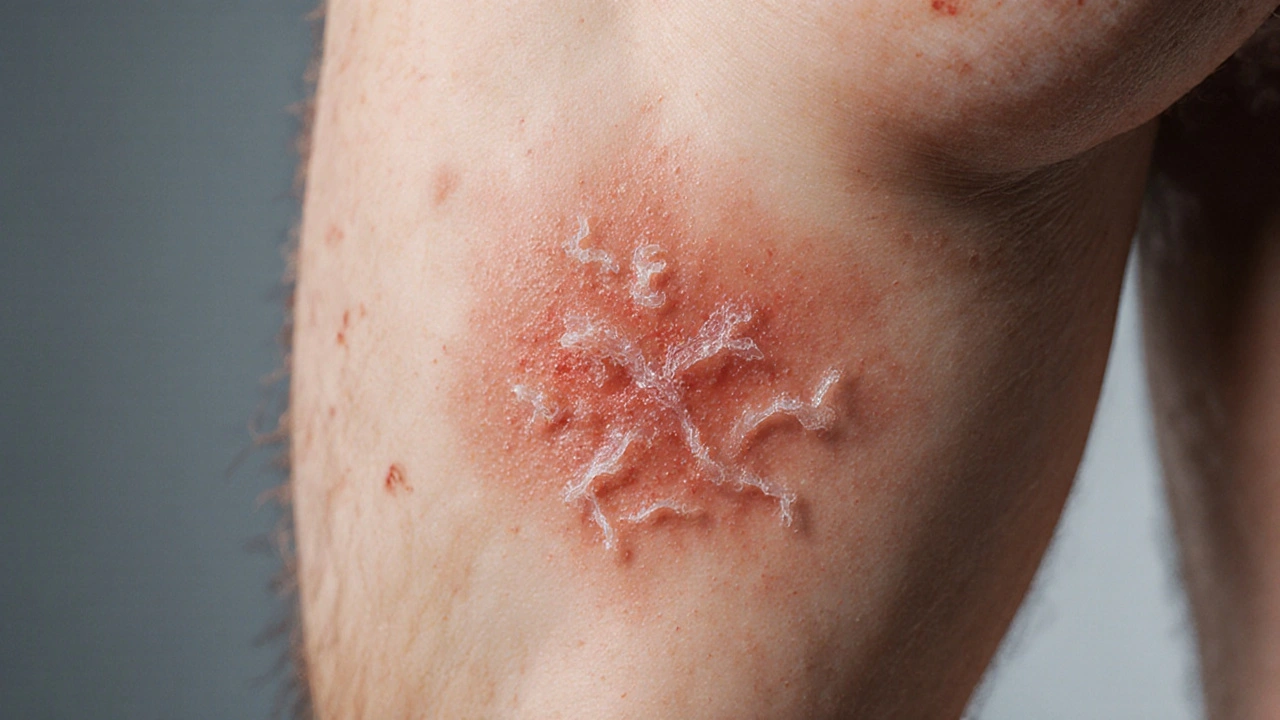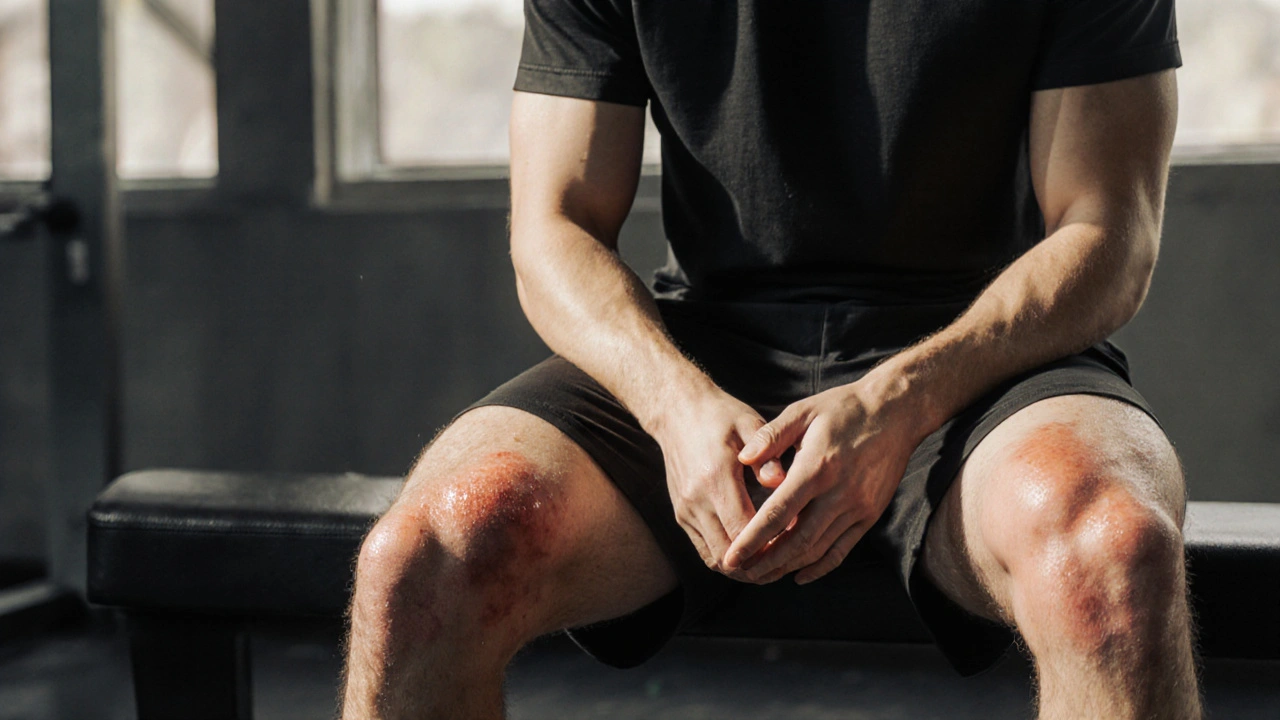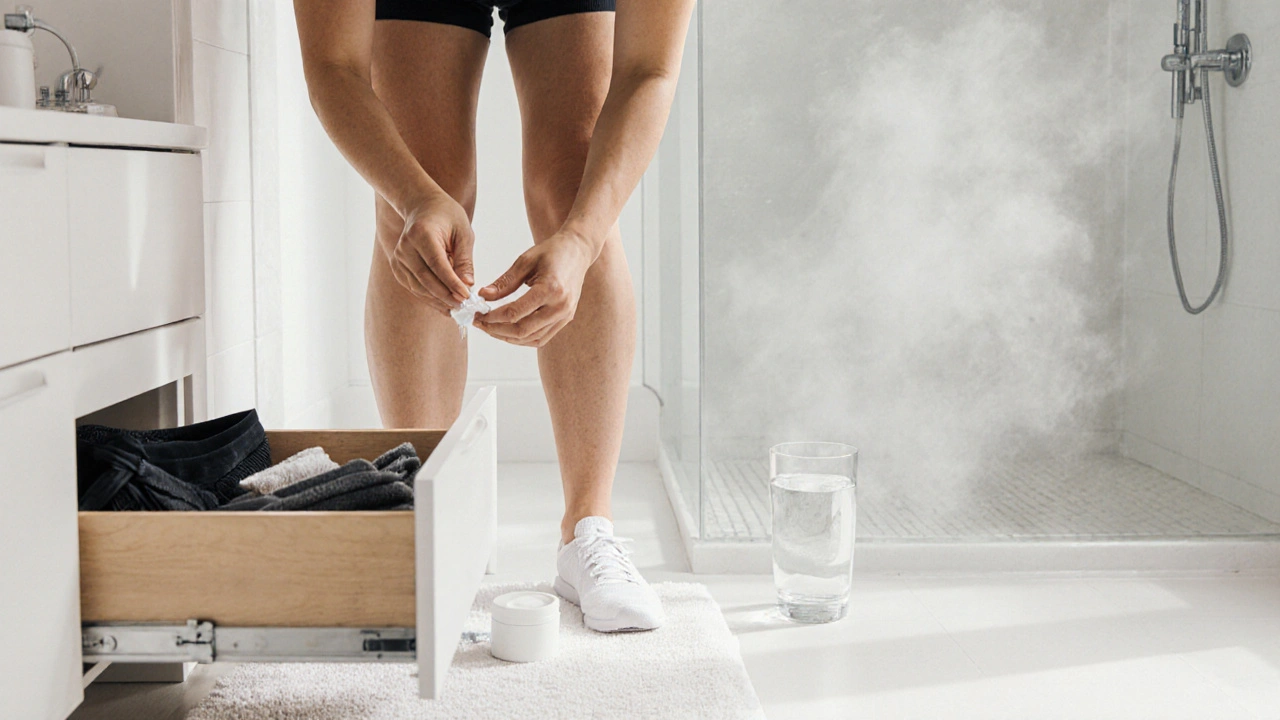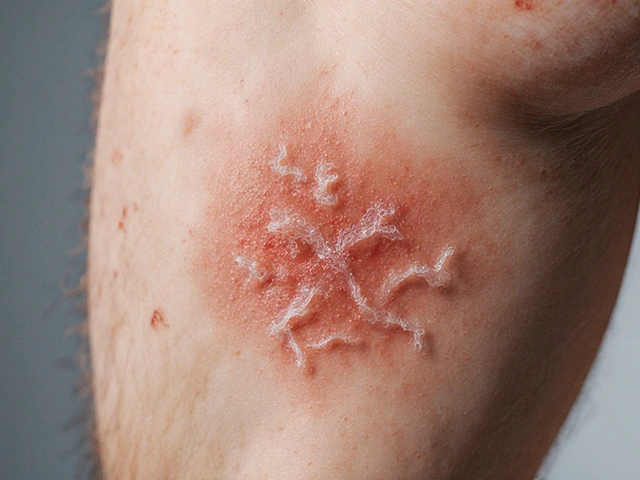
Jock Itch Spread Tracker
Jock itch (tinea cruris) is a fungal infection that can spread to various body parts. This interactive tool helps you understand potential spread pathways and recognize signs of progression.
Inner Thighs and Buttocks
Friction from clothing or movement can drag fungal spores outward.
Genital Area
Same moist environment can spread to penis, scrotum, or labia.
Feet
Athlete's foot and jock itch often occur together.
Underarms
Sweat-rich zones are another favorite spot for dermatophytes.
Other Skin Folds
Warm, damp pockets like behind knees can become secondary sites.
- New red or raised patches appearing outside the original area
- Intensifying itching after showers or activity
- Flaking or scaling extending onto thighs or underarms
- Visible borders with clear edges
- Increased odor in affected area
Daily Habits
- Change sweaty clothes within 2 hours
- Use moisture-wicking underwear
- Apply talc-free powder after showering
- Don't share towels or gym clothes
Environmental Controls
- Wash items in hot water (≥60°C)
- Disinfect shared surfaces
- Avoid tight-fitting clothing
- Maintain dry skin conditions
Answer these questions to assess if your condition may be spreading:
When the groin area starts to itch, flare up, or develop a red rash, most people think of jock itch (tinea cruris) as a simple irritation. But the real question is: can jock itch spread to other body parts? Below you’ll find a step‑by‑step rundown of what the infection is, how it moves, and what you can do to keep it confined.
What Exactly Is Jock Itch?
Jock itch is a fungal infection caused primarily by dermatophytes, a group of molds that love warm, moist skin. The most common culprit is Trichophyton rubrum, followed by Trichophyton mentagrophytes. These fungi thrive in the same environments that cause athlete’s foot and ringworm, which is why you’ll often see them appear together.
How Does Jock Itch Start?
The infection usually begins in the inner thighs, groin folds, or around the genitals-places where skin rubs together and sweats accumulate. A microscopic spore lands on the skin, germinates, and feeds on keratin (the protein in the outer skin layer). If the area stays damp, the fungus multiplies quickly, producing the classic red, scaly, and intensely itchy patch.
Can It Jump to Other Body Parts?
Short answer: yes, it can. The fungus doesn’t limit itself to the groin; it can travel to any skin surface that offers the right conditions. Common migration paths include:
- Inner thighs and buttocks: Friction from clothing or movement can drag fungal spores outward.
- Genital area: The same moist environment that started the infection can spread to the penis, scrotum, or labia.
- Feet: Many people with jock itch also have athlete’s foot. The fungi can move from the feet to the groin via socks or shoes.
- Underarms: Sweat‑rich zones are another favorite spot for dermatophytes.
- Other skin folds: Anywhere you have a warm, damp pocket-like behind the knees-can become a secondary site.
In technical terms, this is called tinea cruris transmission, and it works the same way many other fungal infections spread: through direct skin‑to‑skin contact, contaminated clothing, towels, or even bathroom surfaces.

Signs That the Infection Has Spread
Recognizing a spread early can save you from a larger, more uncomfortable outbreak. Look for these clues:
- New red or raised patches appearing outside the original groin zone.
- Itching that intensifies after a shower or after vigorous activity.
- Flaking or scaling that extends onto the thighs, buttocks, or underarms.
- Visible borders that are slightly raised and may have a clear edge-typical of fungal growth.
- Increased odor in the affected area, a sign that the fungus is metabolizing skin oils.
If you notice any of these, it’s time to act quickly.
Prevention: Keep the Fungus From Moving
The best defense is staying dry and clean. Here are practical steps you can add to your daily routine:
- Change out of sweaty clothes within two hours of finishing exercise.
- Use moisture‑wicking underwear (synthetic blends) instead of cotton.
- Apply a talc‑free powder to the groin after showering to absorb excess moisture.
- Don’t share towels, socks, or gym clothes; wash them in hot water (≥60°C) after each use.
- Disinfect shared surfaces-gym benches, locker room floors-with a bleach‑based cleaner.
- Limit tight‑fitting clothing that traps heat; opt for looser fits when possible.
These habits cut down the environment that dermatophytes need to thrive, making it far harder for the infection to spread.
Treatment Options: From OTC to Prescription
When prevention isn’t enough, treatment steps vary based on severity and how far the infection has traveled. Below is a quick guide.
- Over‑the‑counter (OTC) antifungal creams: Clotrimazole 1%, miconazole 2%, or terbinafine 1% applied twice daily for 2-4 weeks.
- Prescription‑strength topical agents: Ketoconazole 2% cream or econazole nitrate, usually for stubborn cases.
- Oral antifungal pills: For extensive spread, doctors may prescribe terbinafine 250mg daily for 2-4 weeks or itraconazole pulse therapy.
- Adjunct measures: Antifungal powders for the groin and feet, plus regular skin hygiene.
Most people see improvement within a week of consistent use, but completing the full course is crucial to prevent recurrence.

OTC vs Prescription Antifungal Creams: Quick Comparison
| Attribute | OTC Creams | Prescription Creams |
|---|---|---|
| Active Ingredients | Clotrimazole, Miconazole, Terbinafine | Ketoconazole, Econazole, Higher‑strength Terbinafine |
| Typical Duration | 2-4 weeks | 2-3 weeks (often faster symptom relief) |
| Cost (US) | $5‑$15 per tube | $30‑$70 per prescription |
| Availability | Pharmacy shelves, supermarkets | Doctor’s prescription required |
| Best For | First‑time or mild cases | Severe, widespread, or resistant infections |
If you’ve tried an OTC product for a week without any relief, it’s a good sign to schedule a short doctor visit for a prescription option.
When to See a Healthcare Professional
Most jock itch cases resolve with self‑care, but you should get medical help if:
- The rash expands rapidly or involves the genitalia deeply.
- You develop blisters, pus, or a foul smell.
- Symptoms persist beyond four weeks despite treatment.
- You have diabetes, a compromised immune system, or are taking immunosuppressive drugs.
- You notice painful cracks in the skin that may become a portal for bacterial infection.
Getting a proper diagnosis early prevents complications like cellulitis or chronic fungal colonization.
Myths About Jock Itch Spread
There’s a lot of confusion online. Here are the most common myths busted:
- Myth: Jock itch is caused by poor hygiene alone.
Fact: While moisture and friction matter, the fungus itself is the primary cause. Cleanliness helps but doesn’t eliminate the organism. - Myth: You can catch it from a toilet seat.
Fact: Transmission mainly occurs through direct skin contact or contaminated fabrics, not dry surfaces. - Myth: Over‑the‑counter sprays are enough for severe cases.
Fact: Severe or widespread infections often need prescription-strength medication.
Understanding the real drivers lets you target prevention more effectively.
Frequently Asked Questions
Can jock itch spread to the feet?
Yes, many people have both jock itch and athlete’s foot. The same dermatophytes can move from the groin to the feet through socks, shoes, or direct hand contact after touching the infected area.
How long does it take for jock itch to clear?
If you use an appropriate antifungal cream twice daily, most mild cases improve within 5‑7 days, but you should continue the treatment for the full 2‑4 weeks to fully eradicate the fungus.
Is it safe to exercise while treating jock itch?
Exercise itself isn’t harmful, but you need to change out of sweaty clothes immediately, keep the area dry, and reapply the antifungal after showering. Skipping these steps can let the fungus spread.
Can my partner get jock itch from me?
Yes, close skin‑to‑skin contact can pass the spores to a partner, especially in warm, moist areas. Using separate towels and keeping the infection covered reduces risk.
What should I do if the rash returns after treatment?
A recurrence often means the fungus wasn’t fully eliminated or the environment still favors growth. Restart a full course of antifungal, add an antifungal powder for daily maintenance, and double‑check hygiene habits. If it keeps coming back, see a doctor for a possible oral medication.


Jock itch might seem like a minor annoyance, but it can tell us a lot about our daily habits and the environments we share.
When the fungus spreads from the groin to the inner thighs, it's often because tight clothing creates friction that drags spores outward.
Similarly, warm, damp skin folds such as under the arms or behind the knees become perfect breeding grounds for dermatophytes.
One practical step is to change out of sweaty garments within two hours after exercising, which reduces moisture that fuels fungal growth.
Moisture‑wicking underwear made from synthetic blends can help keep the area dry while still being comfortable.
Applying a talc‑free powder after showering adds an extra barrier against humidity.
Don't forget to wash towels, gym clothes, and socks in hot water (at least 60 °C) to kill any lingering spores.
Sharing personal items like razors or shoes can inadvertently pass the infection to a friend or family member.
Regularly disinfecting shared surfaces in locker rooms or bathrooms can cut down on cross‑contamination.
Avoiding tight‑fitting clothing, especially synthetic fabrics, reduces the friction that spreads the fungus.
When you notice new red patches beyond the original area, it may be a sign of spread and warrants a closer look.
Intensified itching after a shower often indicates the skin is rehydrated, giving the fungus a chance to proliferate.
Flaking or scaling extending onto the thighs or underarms should prompt a reassessment of your treatment plan.
Maintaining a dry skin environment, perhaps by lightly patting areas with a clean towel, can be surprisingly effective.
Finally, if over‑the‑counter creams aren't helping, consult a healthcare professional for prescription‑strength options.
I appreciate how the guide breaks down the spread paths clearly. Keeping the skin dry is something we often overlook in daily life. Simple habits like swapping out of damp clothes quickly can make a big difference. It’s also helpful to remember that the same fungus can cause athlete’s foot, so checking the feet is wise.
Yo, this whole jock itch thing is like a stealth ninja infection, sneaking from your groin to your feet while you’re busy not noticing. Guys, if you keep wearing those tighty‑whities, you’re just giving the fungus a free ride on the express lane. Swap ‘em for some breathable gear, or you’ll end up with a full‑blown fungal fiesta. And don’t think washing your hands will fix it – the spores love a good laundry day. Get a proper antifungal powder, not that cheap stuff you find in the snack aisle. Also, stop sharing towels unless you wanna share the itch, lol.
Honestly, this article feels like it’s trying to over‑politicize a simple skin issue. We should focus on facts, not hype. Wear loose clothes and stay dry – that’s it.
Sounds like a pain 🙄
Exactly! Keeping the area dry and swapping out sweaty gear quickly can really curb the spread. A simple daily routine can prevent a lot of discomfort. Keep up the good habits and the fungus won’t stand a chance.
The preventative measures outlined are precise and actionable. It is essential to maintain hygiene and avoid sharing personal items to limit transmission.